The latest multi-vendor marketplace development statistics show the following:
- Online marketplaces globally recorded sales exceeding $3.25 trillion, a 2.9% growth compared to the previous year.
- These sales were largely driven by third-party sellers rather than the platforms themselves.
This shows that marketplaces benefit hugely by collaborating with multiple businesses, rather than solely trading their own merchandise. Multi-vendor marketplaces are on the rise – most of them having sprung up over the past seven or eight years.
- What Is a Multi-Vendor Marketplace?
- Benefits of the Multi-Vendor Marketplace for Everyone Involved
- Multi-Vendor Marketplace Types
- How to Create a Multi-Vendor Marketplace Website
- eCommerce Marketplace Development For Less Than 3 Months: Is It Real?
- How Much Does It Cost to Build a Marketplace Website?
- Multi Vendor Marketplace Development: Which Stack To Choose?
- Create Multi Vendor Marketplace Website On Magento (Adobe Commerce)
- Create a Multi Vendor Marketplace on Shopify
- Create Multi Vendor Marketplace Website On WordPress
- Multi-vendor Marketplace Developers: What Is Their Rate And Where To Find Them?
- Start Building a User-Friendly Multi-Vendor Marketplace
Briefly About the Main Thing
Get an eCommerce Expert Consultation
Our Adobe Business Practitioner will audit and optimize your site for robust performance.

What Is a Multi-Vendor Marketplace?
A multi-vendor marketplace is a digital space that allows many independent sellers to show and sell their goods or services. Like a virtual shopping center, this kind of marketplace presents customers with a wide array of products or services in the same place.
Big names like Amazon and Etsy come to mind right away, but many smaller platforms are also doing well by using this approach. They list hundreds of thousands of items from many sellers, giving customers lots of choice. Plus, they make shopping easy with handy delivery options (like Amazon Prime).
Benefits of the Multi-Vendor Marketplace for Everyone Involved
The multi-vendor marketplace offers unique benefits for all parties – sellers, buyers and marketplace owners.
Benefits for Sellers
Multi-vendor marketplaces usually charge sellers commission. However, it is still usually more profitable for sellers to join this kind of platform, rather than investing in their own marketplace.
Multi-vendor platforms have a lot to offer compared to the independent route, for example:
- Access to a large customer base: Sellers can reach a much larger audience than with a standalone online store.
- Reduced marketing costs: As the marketplace usually invests in attracting consumers, sellers can benefit from these marketing efforts without significant investment on their part.
- Ease of setup and operation: Sellers can avoid the complex processes of setting up a dedicated eCommerce website by simply registering on the marketplace.
Benefits for Buyers
Why would people shop at larger platforms instead of going directly to providers? Perhaps, you can think of several reasons by considering platforms like Amazon, eBay or Etsy.
These reasons include:
- Wide variety of products: Buyers see a huge selection of products or services in one place, which improves user flow.
- Comparative shopping: It’s easy for buyers to compare prices, features and reviews from different sellers in the marketplace.
- Trust and security: Buyers feel more confident purchasing from well-known marketplaces due to established trust and secure payment systems.
Benefits for Marketplace Owners
A multi-vendor marketplace is a cost-efficient way to run an eCommerce business. Other benefits enjoyed by the best multi-vendor marketplaces include:
- Earning potential: Marketplace owners earn a commission on each transaction, which can lead to substantial revenue.
- Lower inventory management: Since the sellers are responsible for managing their own stock, marketplace owners are less concerned with inventory management.
- Customer attraction: Thousands of products generated from many sellers can attract a diverse customer base, increasing traffic and potential profits for the marketplace owner.
Don't Let a Complex Admin Panel Slow You Down
We'll build a user-friendly admin for easy order processing and enhanced marketing and sales opportunities.
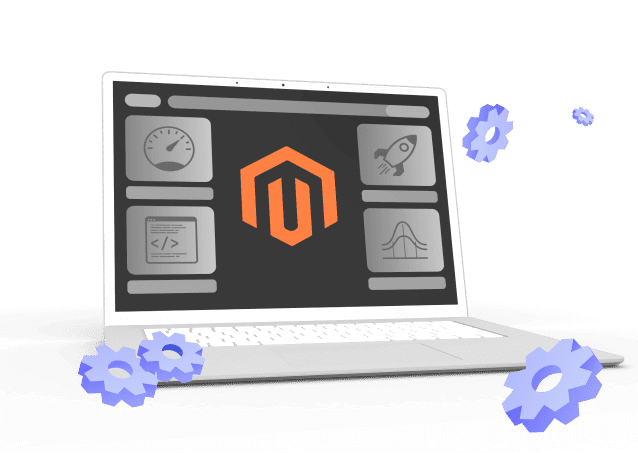
Multi-Vendor Marketplace Types
There are various types of multi-vendor platforms, depending on what the sellers are offering and the audience they aim to serve. By tailoring their platform to specific kinds of products, services or customers, these marketplaces can establish a strong position in the market.
By vendor type
- Product multi-vendor marketplaces: This is the most common type, where businesses offer physical goods. Multi-vendor marketplace examples are Amazon and eBay.
- Service marketplaces: Sellers offer services rather than physical goods. Examples include Fiverr and Upwork, where freelancers offer a variety of services.
- Rental marketplaces: These platforms facilitate the rental of goods. For instance, Airbnb enables property rentals, while Rent the Runway allows for the renting of high-end fashion items.
- Digital product marketplaces: Product providers sell digital goods, like software, digital art or music. Examples include Adobe Stock or iTunes.
- Hybrid marketplaces: These marketplaces offer a mix of products, services, rentals and digital goods.
By audience type
Depending on your target customers, you can choose between several types of marketplaces.
- B2C marketplaces: They cater to transactions between businesses and individual consumers. Amazon and eBay are prime examples, as businesses sell to end consumers.
- B2B marketplaces: These are designed for transactions between businesses. An example is Alibaba, a mostly B2B multi-vendor marketplace where businesses can source products in bulk from manufacturers.
- C2C marketplaces: These platforms connect people who want to sell and those who want to buy – individuals, not businesses. Examples include eBay and Etsy.
- Vertical marketplaces: They cater to a niche audience with specific needs, offering products or services in a single industry or category. For instance, Autotrader is a marketplace specifically for buying and selling cars.
Supercharge Your Store for the Sales Rush!
Ensure peak season success. Our Adobe Business Practitioners conduct site audits to optimize your eCommerce weaknesses.

How to Create a Multi-Vendor Marketplace Website
To make a multi-vendor marketplace, consider the points of view of sellers, buyers and intermediaries (you!). Each group follows its business logic and needs different features and interfaces.
Another challenge is the sheer difficulty of competing with bigger platforms – this issue can be solved with thorough research and planning. Let’s look at the main steps of multi-vendor marketplace development to give you a clear idea of where to start.
1. Choose the business niche
Identifying the right niche for your multi-vendor marketplace platform is the first step. The niche you choose not only determines the products or services sold on your marketplace but also sets the tone for your branding, marketing and customer-engagement strategies.
If there’s high demand for a certain product or service, that’s a promising sign. However, if the market is already saturated with similar offerings, it’s tough to stand out. If a niche is not saturated but there’s low demand, you have fewer customers to work with.
Here are some examples of popular marketplace niches:
- Fashion and apparel
- Electronics and gadgets
- Handmade crafts and jewellery
- Digital products like software, ebooks or music
- Services like home repair, tutoring or graphic design
The trick to ensuring your marketplace’s success is to identify a niche with sufficient demand that isn’t overly saturated.
2. Choose the platform
The next step is the selection of your marketplace platform.
There are numerous platforms pre-equipped with multi-vendor functions. The selection of your multi-vendor marketplace website is reliant on diverse factors such as financial capacity, technical proficiency and particular features you may require for your business.
The most popular options are:
Shopify
Shopify lets users easily construct and manage their online shop. It includes customizable themes and robust eCommerce capabilities like product listings, integrated payment gateways and order management.
The vast array of apps available in its marketplace can greatly expand your store’s functionality. Due to its simplicity and easy setup, it’s popular among small and medium-sized businesses.
WooCommerce
WooCommerce is an adaptable, open-source, eCommerce plugin crafted for WordPress, the world’s most widely used content management system. It gives you the freedom to control every element of your store, including design and features.
With access to countless WordPress themes and plugins, you can tailor your store’s functionality to your unique needs. Keep in mind, this platform may require some technical know-how to maximize its offerings.
Magento
Magento, an open-source eCommerce platform packed with features, is known for its flexibility and scalability, letting businesses adapt and grow their online stores as they expand. Magento provides advanced features like customer segmentation, inventory management and marketing tools.
However, its complexity and the need for more technical knowledge and resources to manage it effectively is something to consider.
3. Choose a monetization strategy
When it comes to deciding on your monetization strategy, an effective method is to conduct research on successful marketplaces within your chosen or similar sectors. Understand their strategies and see how you might tailor them to your marketplace.
As your marketplace expands and user needs shift, it’s crucial to remain adaptable and willing to modify your monetization strategy.
Here are some frequently employed monetization strategies:
- Commission on each sale: This is the most common method of monetization. In this setup, the multi-vendor marketplace website earns a share of every transaction made on the platform. The interests of the marketplace and the sellers are synchronized in this model, with the marketplace generating revenue only when a seller makes a sale.
- Fee for each listed product or service: In this setup, sellers pay a fee to list their products or services on the marketplace. While this can ensure a steady income stream for the marketplace, it could deter some sellers, particularly those with a substantial inventory.
- A subscription fee for sellers to use the marketplace: This approach means asking sellers for a regular fee (monthly, quarterly or yearly) to allow them to use the platform and its features.
Each of these monetization strategies has its own set of advantages and potential challenges. The key is to understand your sellers, your buyers and the unique dynamics of your marketplace to choose a model that serves all parties effectively.
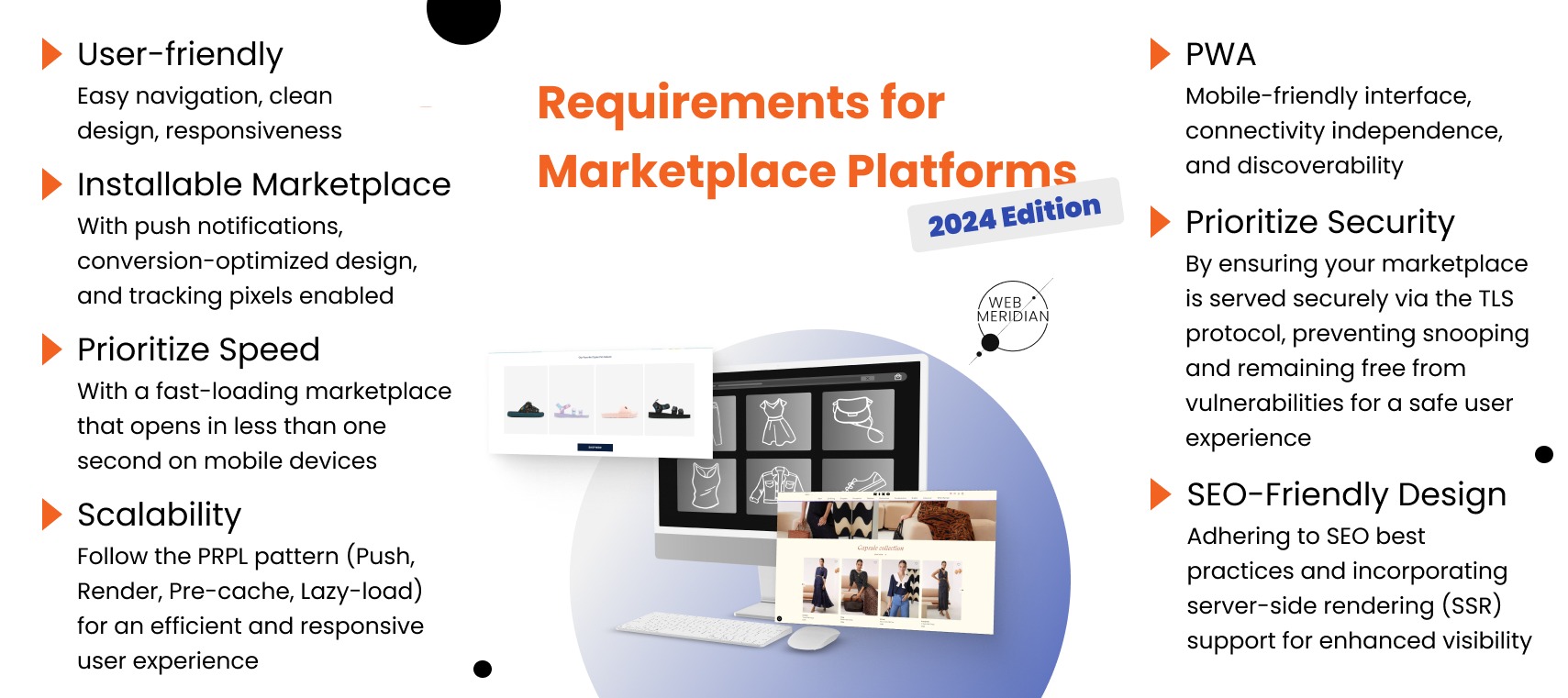
4. Define required features
Your chosen platform should provide a pleasant and intuitive workflow for buyers and sellers.
Here are the key features to consider when you create a multi-vendor marketplace:
- A secure payment gateway: This ensures all transactions on your platform are safe and trustworthy. Make sure your payment gateway supports multiple payment methods, like credit/debit cards, PayPal or digital wallets, to cater to a wide range of user preferences.
- A review and rating system for trust-building: Reviews and ratings are vital for an eCommerce multi-vendor marketplace. They not only help build trust and credibility but also help buyers make informed decisions.
- Search and filter options: Search filters help customers quickly find what they want. The easier it is to find items, the more likely they are to make a purchase.
- Seller dashboard: This lets sellers easily manage their shop. They can track sales, view orders and update product information in one place.
- Shopping cart and wishlist: These help users plan and manage their purchases. A cart stores items for checkout. A wishlist saves items for later.
- Product categories: Organize items to make shopping easier. Categories, for example, can include type, size, colour and brand.
- Coupons and discounts: Help sellers attract more customers. Add functionality to create and apply discounts and change prices automatically when a special offer is applied.
5. Take care of the design
The design of your online multi-vendor marketplace platform is pivotal as it influences how users perceive your platform, how they navigate it, and how easily they can complete actions such as making a purchase or listing a product. A well-designed multi-vendor eCommerce marketplace is not only visually pleasing but also highly functional.
Here are some examples of marketplaces with impressive designs:
ASOS
ASOS, one of the biggest online fashion marketplaces, has a design that suits its fashion-savvy 20-something audience. It has a sleek, modern look with top-notch product photos and in-depth product details. The platform’s strong search and filter tools, simple checkout process and mobile-friendly design boost its usability.
Amazon
Amazon’s design focuses on functionality. While it might not be the most stylish platform, the design does its job – making online shopping simple and quick. The platform is easy to navigate, product listings are thorough, and the review system is user-friendly and plays a big role in the buying process.
Uber Eats
Uber Eats has a good-looking and easy-to-use design that lets users look at menus, order food and track delivery. This marketplace’s attractive food photos and clear pricing info provides a pleasant user experience.
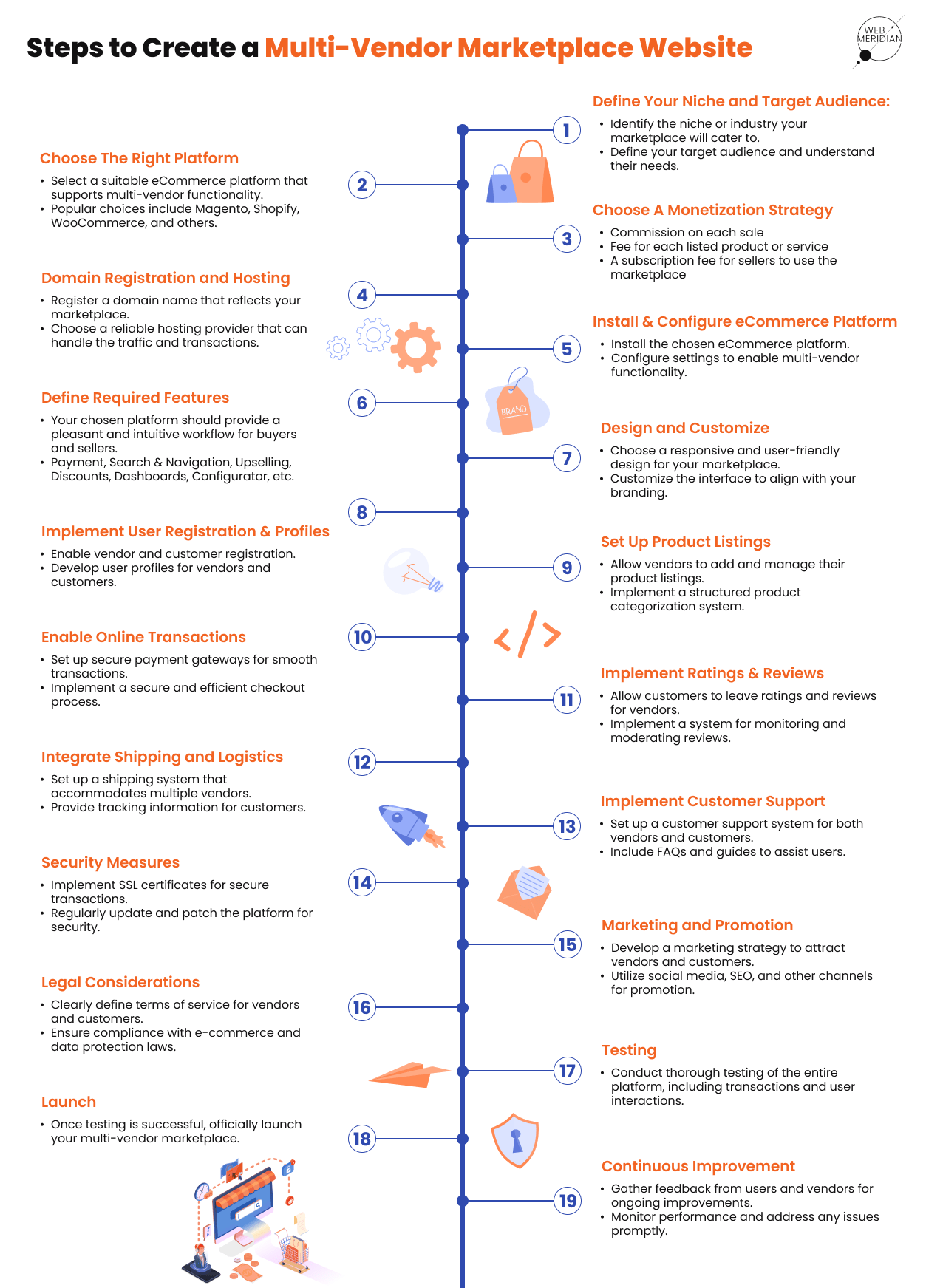
6. Create and launch a marketplace MVP
An MVP –minimum viable product – is a simplified version of your marketplace with just enough features to satisfy early customers and provide feedback for future product development.
Let’s look at the main steps involved in launching a marketplace MVP:
- Test the MVP thoroughly to make sure all features work as they should. This phase may involve beta testers, who are early users willing to provide feedback on your product.
- Collect and analyze feedback from your early users. This can give you insights into what works and what needs improvement.
- Use the feedback you received to refine and improve your marketplace. This might mean tweaking existing features or adding new ones based on user needs.
Once you’re confident that your MVP meets your users’ needs and expectations, it’s time to start building a multi-vendor marketplace with additional features and better design. Bear in mind this is a continuous process, and you will need to keep iterating your product based on user feedback and market trends.
7. Acquire vendors and buyers
When you create a multi-vendor marketplace, you need to offer incentives to sellers and attract buyers at the same time. Their interests are usually opposite: sellers want to charge more, and buyers want to spend less. To keep everyone happy, offer benefits that are less about price and more about accessibility and convenience.
Attracting sellers
- Direct outreach: Identify potential vendors who would benefit from selling on your platform and reach out to them directly. This could involve emails, phone calls, or even in-person meetings. The goal is to convince them of the benefits of joining your marketplace, such as reaching a larger audience or having access to advanced selling tools.
- Partnerships: Establishing partnerships with related businesses or industry influencers really helps attract vendors. Partners can endorse your marketplace and provide a trusted recommendatio to their network, which always creates more trust than ads do.
- Incentives for early adopters: Early adopters are vendors who join your marketplace in its early stages. Offering them bonuses, like reduced commission rates or premium listings, is a good way to attract them to your platform. Early adopters not only help you start generating revenue but also attract other vendors to your marketplace (and even create FOMO – fear of missing out).
Attracting buyers
- SEO and content marketing: Implementing a strong SEO strategy can help your marketplace rank higher in search engine results, increasing its visibility to potential buyers. Providing valuable content, like buying guides or product comparisons, can also attract buyers and encourage them to make purchases.
- Social media advertising: With billions of users worldwide, social media platforms offer a huge potential audience for your site. Just pick the platform where your target audience is likely to be, then test different ads to figure out what works.
- Email marketing: Building an email list and regularly sending out newsletters or promotional materials can keep your marketplace in mind for potential buyers. It’s also a great way to announce new products, sales or features.
If you think it’s enough to simply create a multi-vendor eCommerce marketplace website and let people come to you, you need to reconsider. In reality, acquiring vendors and buyers is an ongoing process. You’ll need to continually promote your marketplace, offer attractive deals, and ensure a seamless user experience to keep attracting and retaining users.
8. Promote and grow
Even if you are just starting out, you need to have ideas on how to promote and grow your marketplace. You need to think of ways to create awareness, attract more users (vendors and buyers), and continually improve your marketplace based on feedback and market trends.
Here’s a detailed approach to creating a multi-vendor marketplace that will attract traffic:
- Marketing and promotion: Use various marketing channels and techniques like social media, content marketing, search engine optimization (SEO) and paid advertising to create awareness and attract users. Remember, your marketing efforts should be tailored to your target audience.
- Partner with influencers: Influencers in your niche can help spread the word about your marketplace. They have a ready-made audience that trusts their recommendations, making them a powerful promotional tool.
- User engagement: Engage with your users through newsletters, social media interactions and regular updates about new features or offerings. You want to build a community around your marketplace.
- Referral programmes: Encourage your existing users to refer new users. Offer incentives like discounts or exclusive features to motivate them. Referral programmes can be an effective way to grow your user base.
- Customer service: Excellent customer service keeps customers coming back. Ensure your users’ queries and complaints are handled promptly and efficiently.
Your goal is to provide an excellent user workflow that keeps users returning and attracts new ones.
eCommerce Marketplace Development For Less Than 3 Months: Is It Real?
Ever thought about how a big shot like Amazon got its start? How did it look way back in the day? Take a peek at this snapshot we found of Amazon from decades ago.
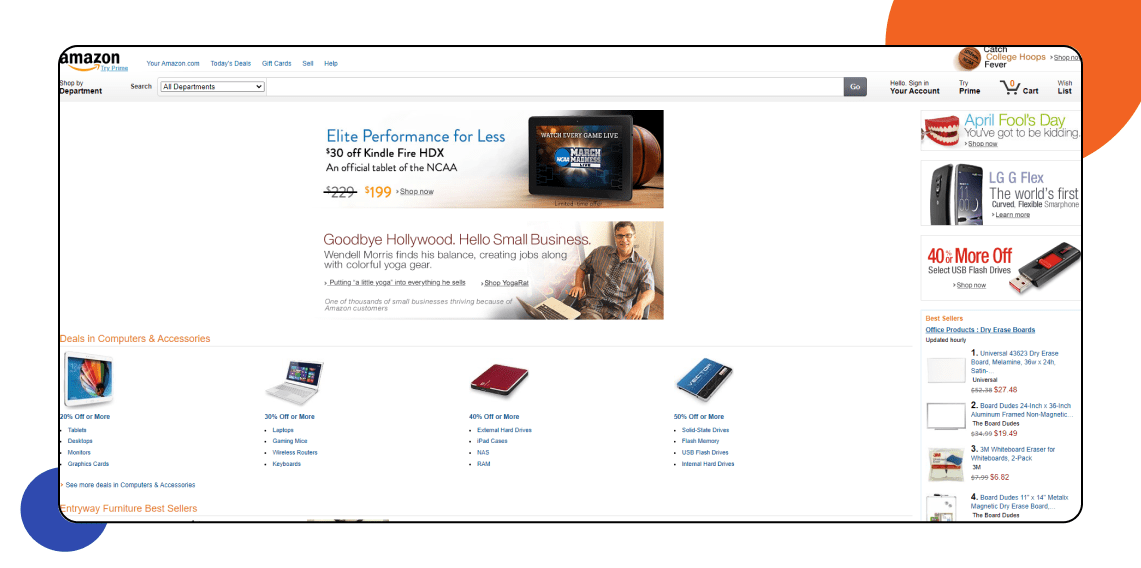
Yep, you guessed it right – it all kicked off with an MVP.
In the fast-paced eCommerce business, the prospect of developing a fully functional multi vendor marketplace website within a limited timeframe – less than 3 months – may seem like an ambitious feat. However, it is absolutely possible if you choose the right strategy and the right tech stack.
Many years ago even an MVP was a challenge but nowadays the quick start is possible. The 2 main rules are:
1) Don’t opt for custom development from scratch. It’s very expensive, time-consuming, and prone to more bugs compared to using ready-made solutions, resulting in delays and increased costs for marketplace development. Since this is a development from scratch, you will most likely encounter many bugs, simply because they have not yet been tested in real shopping and transactions.
2) Choose a pre-made solution for your eCommerce needs – CMS. We recommend Magento 2 as it makes the development process 2-3 times faster due to the numerous pre-built extensions and modules. And it definitely costs up to 3-5 times less than developing a website like Amazon from scratch. This solution has undergone extensive testing through years of worldwide use: billions of products placed, and thousands of shops created. To take the edge off multi-vendor marketplace development, Magento 2 is the right choice.
WebMeridian’s Multi-Vendor Marketplace Development Case
In this section, we’ll share our experience developing a successful multi vendor marketplace website using Magento 2 within 3 months. We respect the confidentiality of our project under NDA, so we’ll reveal insights only into the development timeline, core functionalities, and approximate costs involved.
The client’s objective was to develop an MVP version of a marketplace within a tight timeline.
The marketplace functionality client requested for the MVP:
Customers-Related Features
- Customer account
- Search and advanced filters
- Cart and checkout
- Reviews and ratings
- Similar products
- Shipping tracking and order history
- Loyalty programs and discounts
- Payment (Paypal, Stripe, Adyen)
- Excellent UX: no more than 3 clicks to place the product in the cart
Vendors-Related Features
- Admin account and multi-level access for numerous vendors
- Onboarding an unlimited number of vendors to your store
- Agile commissions setup for each separate vendor
- Setup of vendor and product validation according to your business model
- Inventory and Order management
- Comprehensive analytics of purchases and transactions
- Transactions and payouts management from the admin panel
- Integration of APIs to add products directly from Amazon and Cdiscount
But how did we actually manage to develop such a marketplace so quickly?
One of the keys to success was setting up pre-made Magento modules and extensions. In this case, we configured the following extensions:
In terms of the time taken to implement each aspect by our team, here’s the breakdown:
| Direction | Hours |
|---|---|
| Design | 100 |
| Front-end Development | 250 |
| Back-end Development | 300 |
| DevOps | 40 |
| QA | 90 |
So as you can see, leveraging pre-built solutions like Magento 2 and focusing on an MVP approach allowed WebMeridian to swiftly create a multi-vendor eCommerce platform within 3 months. Avoiding custom development and utilising ready-made extensions enabled the incorporation of essential customer and vendor functionalities efficiently. As a result, the client was able to launch the business online asap.
How Much Does It Cost to Build a Marketplace Website?
The cost of building a marketplace website depends on the vendor’s location, scope of work, design complexity, chosen tech stack, integrations involved etc. The factors are almost unlimited. But if we speak of an average estimate for a multi vendor marketplace website MVP, it would range from $29,000 to $40,000+. Here’s the detailed breakdown:
| Development Stages | Timeframe, hours | Average Rate, $ | Total Costs |
|---|---|---|---|
| Design | 100 | 30 | 3000 |
| Front-end Development | 250 | 35 | 8750 |
| Back-end Development | 300 | 40 | 12000 |
| DevOps | 40 | 30 | 1200 |
| QA | 90 | 25 | 2250 |
| PM | 100 | 25 | 2500 |
| 880 Hours | $29700 |
Reducing the expenses of developing a marketplace like Amazon, is feasible by collaborating with reputable partners. But you should keep in mind that we’ve provided the estimates based on the average hourly rates. It’s obvious that the developers from Eastern Europe cost less than those from the USA. For a glimpse, here’s an approximate breakdown of marketplace website costs across various regions in 2023, sourced from Clutch rates:
| Location | Marketplace Cost | Average hourly rate |
|---|---|---|
| Eastern and Central Europe | $41,200 | $50/h |
| Western Europe | $82,400 | $100/h |
| USA | $123,600 | $150/h |
| Australia | $82,400 | $100/h |
Typically, it’s difficult for development companies to offer precise figures without a comprehensive understanding of specific needs and technical requirements. For an accurate cost estimate tailored to your online marketplace, consider engaging a certified software development company or at least booking a free consultation to get your project pre-estimated.
Multi Vendor Marketplace Development: Which Stack To Choose?
Generally, Multi-Vendor Marketplace development offers numerous options, from custom development to utilizing various platforms or content management systems (CMS). In this article, we will delve into the key development choices, providing a comprehensive analysis to guide you through the best option among them all.
Custom Vendor Marketplace Development? Don’t even think about it.
Planning to build your own Multi Vendor Marketplace from scratch? It sounds exciting but wait – it’s a road paved with challenges.
It Takes a Lot of Time
Custom multi vendor marketplace development is like building a house from the ground up. It’s a long journey, often stretching over months or even years. You’re not just setting up a website; you’re creating every single feature from zero.
Costs More Than You Think
Building a custom website isn’t cheap. From hiring developers to ongoing maintenance, the bills add up quickly. And unlike using a ready-made platform, these costs don’t stop after the launch. You’ll keep paying for updates and fixes. The cost of building a custom multi-vendor store typically starts around $80-120K, but with a ready CMS/builders it’ll be at least ten times less.
You Need Tech Wizards
To go custom, you need a team of tech pros – developers, designers, DevOps, QA engineers, and more. Finding the right people isn’t easy, and it certainly isn’t cheap. Plus, tech changes fast. Your team will need to keep learning to stay up-to-date.
Maintenance? All on You
With custom multi vendor ecommerce development, there’s no help desk to call when things go wrong. Every bug, every update is your responsibility. This means more time and money spent on keeping your site running smoothly.
Growing Pains
As your business grows, your custom site needs to grow too. Scaling up a custom-built site can be tricky and expensive, often requiring big changes to handle more users and products.
Playing Nice with Others
Custom sites can be stubborn about working with other tools and services, like payment systems or marketing software. Getting everything to work together nicely can be a headache.
The Risk Factor
Custom ecommerce marketplace development is risky. Even with a solid plan, things do not work out as expected. Maybe the site doesn’t work as well as you hoped, or customers don’t love it. With a pre-built platform, you’re using something that’s already been tested and approved by others.
Create Multi Vendor Marketplace Website On Magento (Adobe Commerce)
Magento is an open-source e-commerce platform written in PHP. It’s widely used for developing online shopping websites and offers a flexible shopping cart system, as well as control over the look, content, and functionality of online stores. Magento also offers powerful marketing, search engine optimization (SEO), and catalog-management tools.
- Flexibility and extensibility: Magento is an open and flexible solution that allows you to easily customize and extend functionality. This is important for creating a multi-vendor marketplace where you need to accommodate a variety of business models and vendor requirements.
- Powerful management tools: Magento provides tools to manage orders, inventory, delivery tracking and other key aspects of e-commerce. This ensures efficient management of multi-seller marketplace operations.
- Extensive functionality: The platform comes with extensive functionality to manage products, categories, pricing and many other aspects of an online store. This makes it suitable for building complex multi-vendor platforms.
- Security: Magento is actively updated and provides a high level of security. This is important, especially when handling transactions and data from multiple sellers and buyers.
- Multi-user admin panel: Magento provides the ability to create multi-user accounts with different access levels, making it easy to create a multi vendor marketplace website.
Marketplace Multi Vendor Extension Modules for Magento
Magento comes with tons of innovative extensions designed to transform your Magento store into a thriving multi-vendor marketplace. They offer seamless integration, allowing multiple vendors to manage their products, orders, and shipping while providing customers with a diverse shopping experience. Let’s take a look at the best options on the market.
Marketplace Multi Vendor Module for Magento 2 (by TrueMart Team)
Features:
- Transforms Magento 2 stores into multi-seller marketplaces.
- Allows vendors to manage product listings, inventory, orders, and profiles.
- Supports various product types.
- Integrates with major shipping and payment services.
- Includes over 160 marketplace add-ons.
- Available for mobile (Android & iOS).
Multi-Vendor Marketplace Platinum Package for Magento 2
Features:
- Converts a single-seller website into a robust multi-vendor e-commerce marketplace.
- Advanced features similar to Amazon and eBay.
- Efficient product handling and sale functionalities for vendors.
- Seamless management capabilities for marketplace owners.
- Additional leverage for vendors in marketing products, managing orders, and viewing sales reports.
Marketplace Multi Vendor Module (by Webkul)
Features:
- Vendor product, order, and shipment management
- Admin approval for vendors and products
- Separate seller profile pages
- Support for multiple product types
- Commission management
Top Questions for a Certified Adobe Commerce Expert and Answers
We asked a multi-vendor ecommerce marketplace development expert questions that business owners often have when they are planning a project. Hopefully, these answers will give you an idea of what to expect from the project and how to make the most out of your concept.
Kate Odyntsova
WebMeridian Project Manager with over 5 years of experience helped us to answer some frequently asked questions about multi-vendor store development.

Q: Do you need to be a technical person to set up an eCommerce marketplace using Shopify or Magento?
A: Both Shopify and Magento have tools to create a multi-vendor marketplace. If you need a simple store and you don’t have technical skills, Shopify might be a good option for you. However, if flexibility and customization are important to you, Magento is a better choice as Shopify usually lacks customization tools.
To create a powerful multi-seller store on Magento, I recommend having a technical advisor by your side. After the store is set up, any person without technical knowledge can operate it. But during the initial development, it’s better to take care that your theme is compatible with the plugins you’re looking to use or to beware of versions updates. Most extensions require technical understanding of how it works with your specific theme, and if something goes wrong, you need to be ready to customise it accordingly. Only developers know all these pitfalls.
Q: What functionality is typical for Multi-Vendor Marketplaces?
A: Typical features are:
- Secure payment gateway
- Search and filter options
- Seller dashboard
- Shopping cart and wishlist
- Product categories to make shopping easier
- Abandoned cart
- Coupons and discounts to attract more customers
- Reviews and rating system for trust-building
Everything is like Amazon.
Q: What is the cost of Multi-Vendor Marketplaces Development?
A: A typical answer would be “it depends”. But from my perspective, the smallest multi-vendor marketplace on Magento or Shopify may cost 5,000 EUR. A big one may reach up to 30,000 EUR depending on the customisations you need. It includes specific design, various payment integrations, advanced analytics, built-in marketing optimization tools, advanced filters, inventory management, orders tracking, custom ideas, etc.
Q: Do multi-vendor marketplaces allow individual sellers to set up their own payment methods, analytics, and account details separately?
A: Yes, but this is not always a ready-made, out-of-the-box solution. It requires modules and its customisation by developers.
Q: Is it possible to configure the marketplace so a user orders goods from different sellers, but payments are made separately for each supplier and payments are sent separately to these sellers?
A: Yes, it is possible but it’s also not an out-of-the-box solution.
Magento has various modules that extend multi-vendor functionality. These modules usually include separate processing orders from different suppliers. You can configure payment gateways that support split transactions to send payments directly to the respective suppliers.
Shopify offers a wide range of apps that can help organise sales from different suppliers. Also, you can integrate Shopify API with external payment systems that enable split payments. One more way is custom development to reach your split-payment goals.
Q: Do Magento and Shopify allow you to deploy a multi-vendor platform on your own server? What about security and data protection?
A: Magento is an open source, which means you can host it on your own server or use a cloud-based solution. This flexibility allows for more control over the hosting environment and infrastructure. Being self-hosted gives you more responsibility for implementing security measures such as SSL certificates. As a hosted platform, Shopify takes care of security and data protection measures. They have robust security protocols to protect customer data and transactions.
Create a Multi Vendor Marketplace on Shopify
Shopify is an e-commerce platform that allows individuals and businesses to create their own online stores. It provides a suite of services, including payments, marketing, shipping, and customer engagement tools, to simplify the process of running an online store for small merchants. Shopify offers several advantages for multi vendor eCommerce development, making it a popular choice among entrepreneurs and businesses. Here are some of the key benefits:
- User-Friendly Interface: Shopify is known for its intuitive and user-friendly interface, making it easy for marketplace owners to set up and manage their online store without needing extensive technical knowledge.
- Reliable Hosting and Performance: Shopify provides reliable hosting solutions, ensuring that your marketplace is always online with minimal downtime. It also handles traffic spikes efficiently, which is crucial for marketplaces expecting high volumes of visitors.
- Built-In Payment Processing: Shopify Payments simplifies the process of receiving payments from customers, supporting various payment methods and currencies. This is particularly beneficial for marketplaces with international transactions.
- Customization and Flexibility: Although Shopify is a hosted platform, it offers considerable flexibility in terms of customization. Users can choose from a wide range of themes and use Shopify’s Liquid language for deeper customizations.
- Extensive App Marketplace: Shopify’s App Store has a wide range of plugins and apps specifically designed for multi-vendor marketplaces. These apps can extend the functionality of your marketplace in various ways, from vendor management to customer relationship tools.
- SEO and Marketing Tools: Shopify includes built-in SEO features and marketing tools that help increase the visibility of your marketplace. This includes options for social media integration, email marketing, and analytics.
- Scalability: As your marketplace grows, Shopify can scale with your business. It can handle an increase in products, vendors, and traffic without compromising on performance.
- Security and Compliance: Shopify takes care of all the security updates and compliance requirements, ensuring that your marketplace is secure and compliant with the latest regulations.
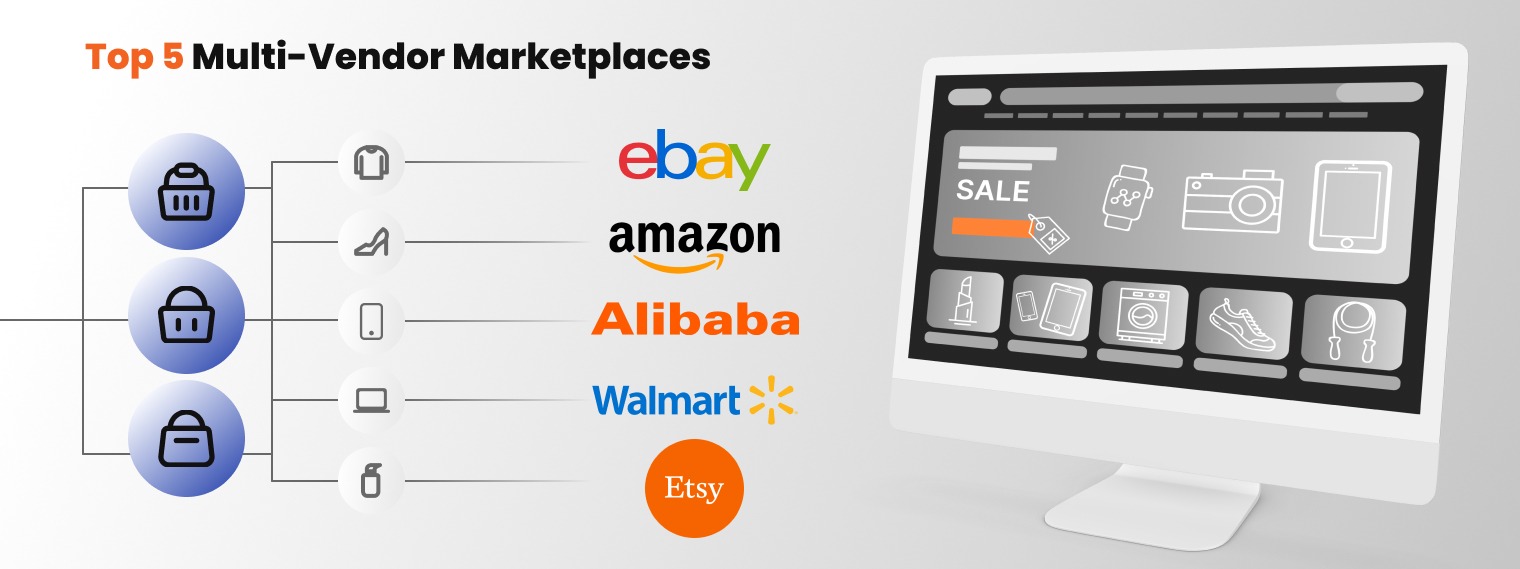
Top Questions for a Shopify Multi Vendor Marketplace Developer
Oleg Fediv, a Senior Shopify developer with over a decade of experience in Shopify solutions, including multi vendor eСommerce development, addresses 4 key questions from our clients. We aim to simplify the process of eCommerce marketplace development for you with this straightforward guidance. Let’s dive in!
Q1: Do Shopify capabilities allow to development of a Multi Vendor Marketplace?
A1: While Shopify doesn’t offer built-in features specifically for creating a marketplace, using existing tools is still feasible. There are apps available, like “Multi Vendor Marketplace – Convert your eCommerce Store to a Fully Fledged Marketplace | Shopify App Store” on the Shopify App Store, that streamline the process. Additionally, Shopify functions like a marketplace where the store owner acts as a vendor. There’s a neat feature allowing you to sell your own products within the Shopify store, accessible through a dedicated mobile application.
Q2: Is it possible to set up a separate dashboard in Shopify for each seller to set up their own payment methods, analytics, and account details separately?
A2: While Shopify doesn’t provide separate panels for each seller, you can customize accounts to access all relevant data except for payment settings. Payment information is typically managed solely by the store owner.
Get a Shopify Expert Consultation
Let our senior Shopify developer analyze your store and provide a comprehensive plan for eCommerce optimization to make your website stand out.

Q3: Is it possible to configure the marketplace so a user orders goods from different sellers, but payments are made separately for each supplier and payments are sent separately to these sellers?
A3: If a customer purchases products from multiple vendors in a single checkout, you’ll need to calculate appropriate payouts or utilize existing solutions. For instance, referral apps can display information based on the vendor or referral, or through alternative methods for the intermediary.
The process is straightforward: you install the app, and it allocates commissions according to predefined rules. For instance, if a single checkout includes purchases from three vendors, the app distributes funds to each vendor based on their respective sales.
Here are some applications recommended by our multi vendor marketplace developer to automate these calculations:
Q4: Can the rating and review system be customized for each seller’s products?
A4: Yes, it’s possible. Product reviews are typically linked to the product ID. When there are multiple identical products from different vendors, these are considered distinct products in the system, so customization for each seller’s products is feasible without issues.
Top Modules for Multi-Vendor Marketplace and Their Features
If you create multi-vendor marketplace all on your own, it’s going to take a lot of time and resources. Shopify also offers ready modules is a great way to conquer this hurdle.
Here’s the list of our favourite Magento extensions with their features, advantages and drawbacks.
Shopify Multi Vendor Marketplace by Webkul:
- Vendor Management: Easy management of vendors, including their products, orders, and earnings.
- Commission Management: Set different commission rates for different vendors.
- Separate Vendor Panel: Vendors get their own panel to manage their products, orders, and profile.
Marketplace in a Box by Jetti:
- Dropshipping Automation: Automates dropshipping processes directly from vendors.
- Inventory Sync: Real-time inventory synchronization from multiple vendors.
- Vendor Payouts: Automated calculation and distribution of vendor payouts.
Multi Vendor Marketplace by Bold:
- Customizable Vendor Profiles: Vendors can create and customize their profiles.
- Product Approval Workflow: Admins can review and approve vendor products before they go live.
- Real-Time Sales Reports: Detailed sales reporting for both admin and vendors.
Marketplace by Modulify:
- Vendor Subscription Plans: Create different subscription plans for vendors.
- Direct Customer-to-Vendor Payments: Allows customers to pay vendors directly.
- Flexible Shipping Options: Vendors can set their own shipping rates and methods.
Vendify:
- Intuitive Vendor Dashboard: Easy-to-use dashboard for vendors to manage their business.
- Product Import/Export: Vendors can easily import or export their products.
- Integrated Review System: Customers can review products and vendors directly on the platform.
Each of these modules offers unique features catering to different aspects of running a multi-vendor marketplace, from vendor management to seamless integration of various operational functions. This makes Shopify a robust and versatile platform for building a multi-vendor marketplace. To integrate
Comparing Magento vs Shopify
Compared to Shopify, Magento has a clear edge in a couple of key areas:
- Customization and Flexibility: Magento is more customizable than Shopify. It offers a multi vendor marketplace open source platform, meaning you can change almost anything you want, which is great for unique business needs. Shopify is easier to use but doesn’t offer the same level of deep customization.
- Handling Growth: Magento is better for large-scale operations. It can manage lots of products and high customer traffic easily, making it ideal for businesses that plan to grow big. Shopify can handle growth too, but it might struggle with very large or complex stores.
- Features: Magento comes loaded with lots of features right from the start, especially in its Commerce version. It has advanced tools for marketing, managing customers, and products. Shopify has good features too, but you might need extra plugins for some advanced functions.
- SEO and Performance: Magento offers more control over SEO, helping your marketplace show up better in search results. Shopify does a good job with basic SEO, but Magento gives you more detailed options.
- Multi-Vendor Features: Magento can be equipped with special extensions for running a multi-vendor marketplace, offering a more tailored and powerful setup. Shopify relies on apps for this, which may not be as fully integrated or detailed.
Considering these factors, Magento is a stronger choice for businesses looking for deep customization, ability to scale up, comprehensive features, and more control over their online multi-vendor marketplace development.
Create Multi Vendor Marketplace Website On WordPress
Advantages of WordPress for eCommerce marketplace development
WordPress is awesome for multi-vendor marketplace development. It’s super flexible, easy to use, and there’s a huge community to help you out.
Why WordPress is a champ for marketplaces:
Customizable: Want a unique look? No prob! WordPress lets you tweak everything.
Scalable: Your marketplace grows? WordPress can handle it. More sellers, more products – no sweat.
Easy to use: Even if you’re not tech-savvy, you can manage your store.
Big community: Need help? There are tons of people online ready to assist.
Cheap to start: WordPress is free, and you can find affordable themes and plugins.
But watch out – WordPress isn’t perfect. Sometimes plugins fight with each other, and security can be a pain. Also, as your marketplace grows, costs for plugins, themes, and hosting can add up. Therefore, you’ll probably need a multi-vendor marketplace developer.
So, while WordPress is a great starting point, plan carefully. Pick the right plugins, find a solid host, and keep an eye on security. With the right approach, multi-vendor eCommerce website development will be easy and hassle-free.
Optimize Your Website Properly
Gain valuable insights and recommendations through our comprehensive Magento code audit services. Discover potential areas for improvement and enhance your website's performance with our expert guidance.

10 Best WordPress Themes for eCommerce Marketplace Development
Building a multi-vendor marketplace? That means, you’ll be needing a good base for it. The right choice of a WordPress theme can make all the difference. Below are the 10 best choices to begin with for establishing your multi-vendor eCommerce site.
Wolmart is a powerhouse theme with features galore. Think layout, product, and even footer builders. It’s like having a design team on call. Plus, it works great with popular marketplace plugins.
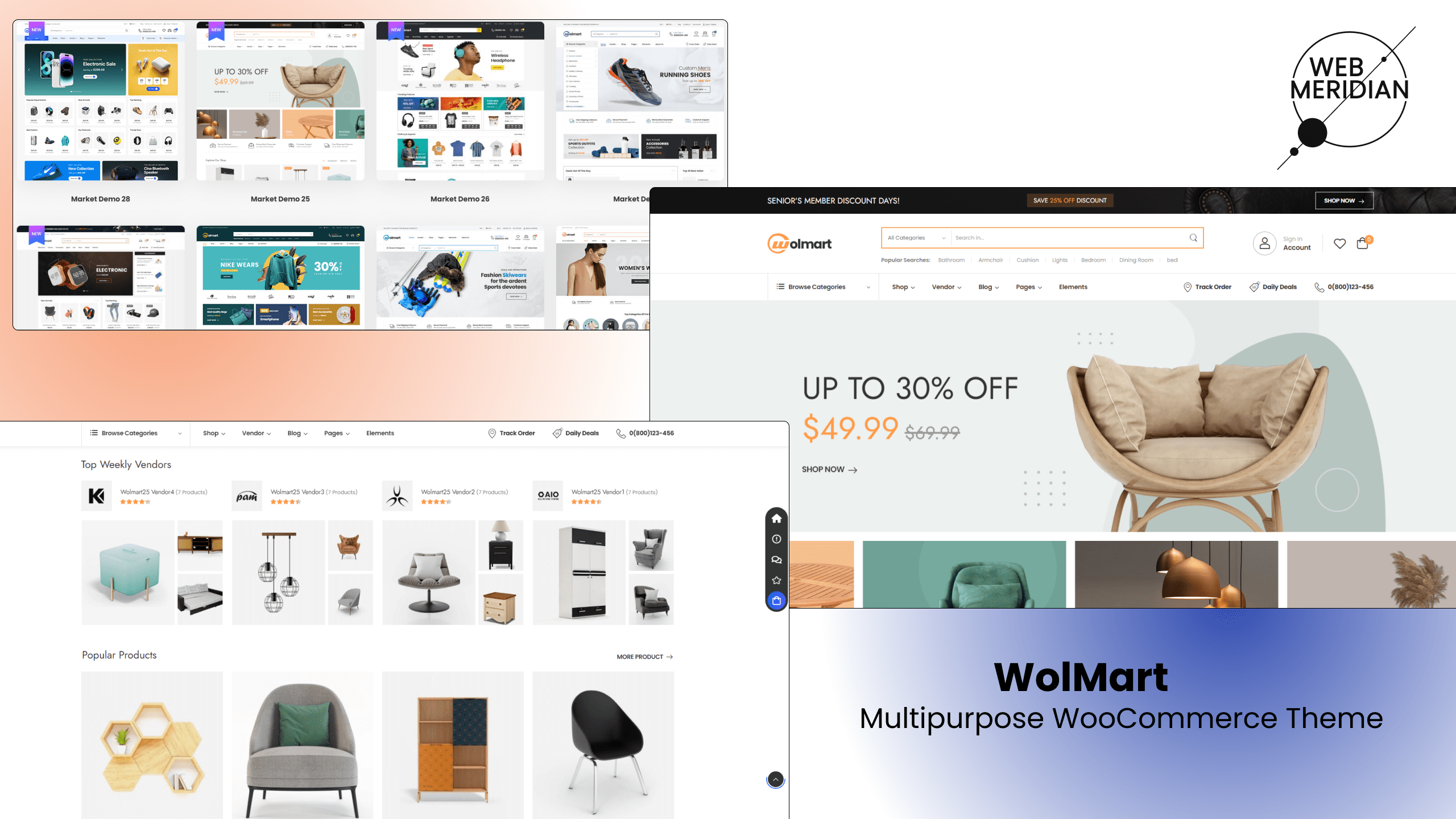
Porto is a versatile player. Not just for marketplaces, it handles everything. Its live search is a real standout feature.
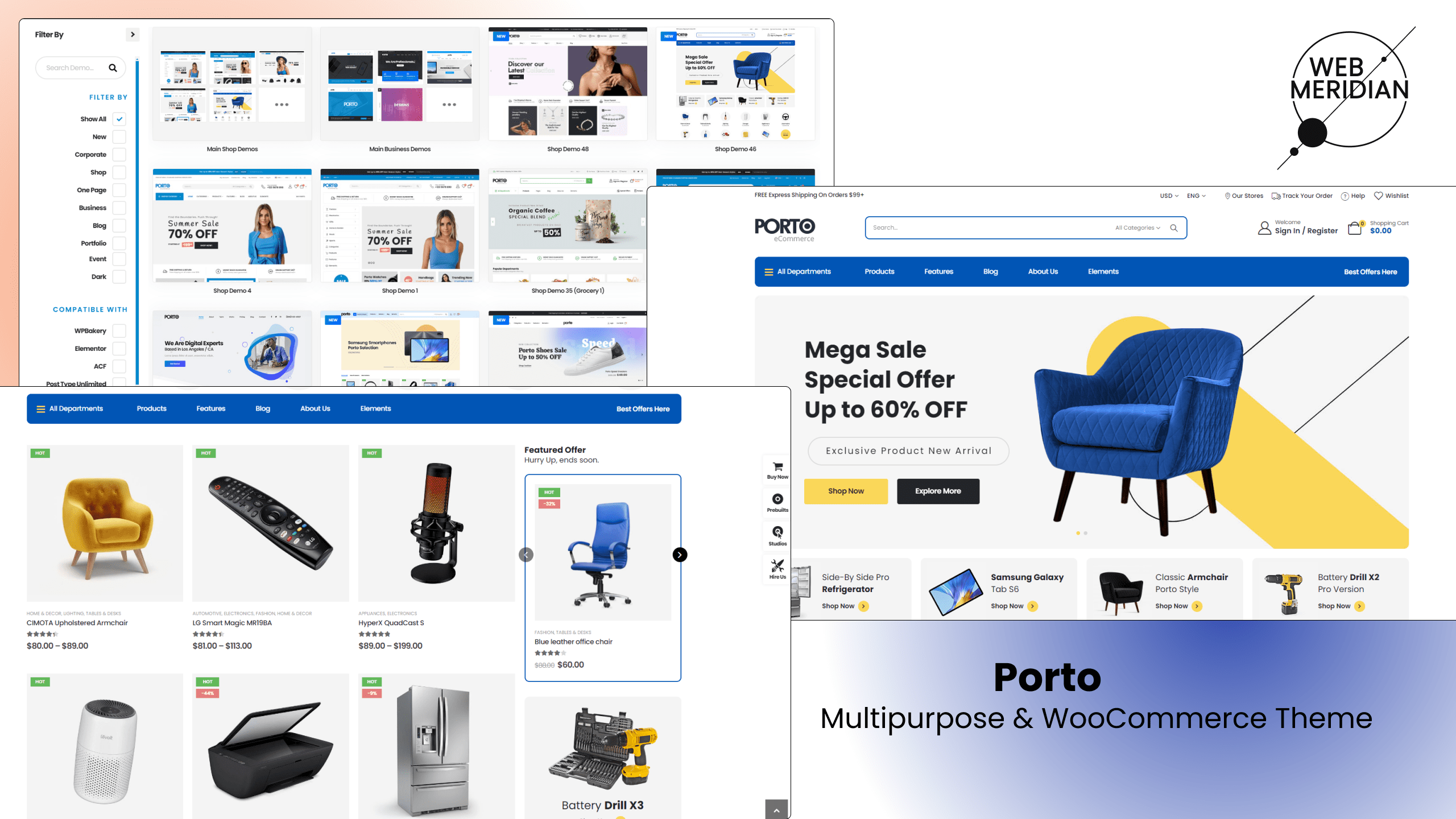
Woodmart is all about speed and ease. If you want a theme that doesn’t slow you down, this is it. Their support team is top-notch too.
Onemall is a creative’s dream. Customize to your heart’s content. It looks amazing on all devices.
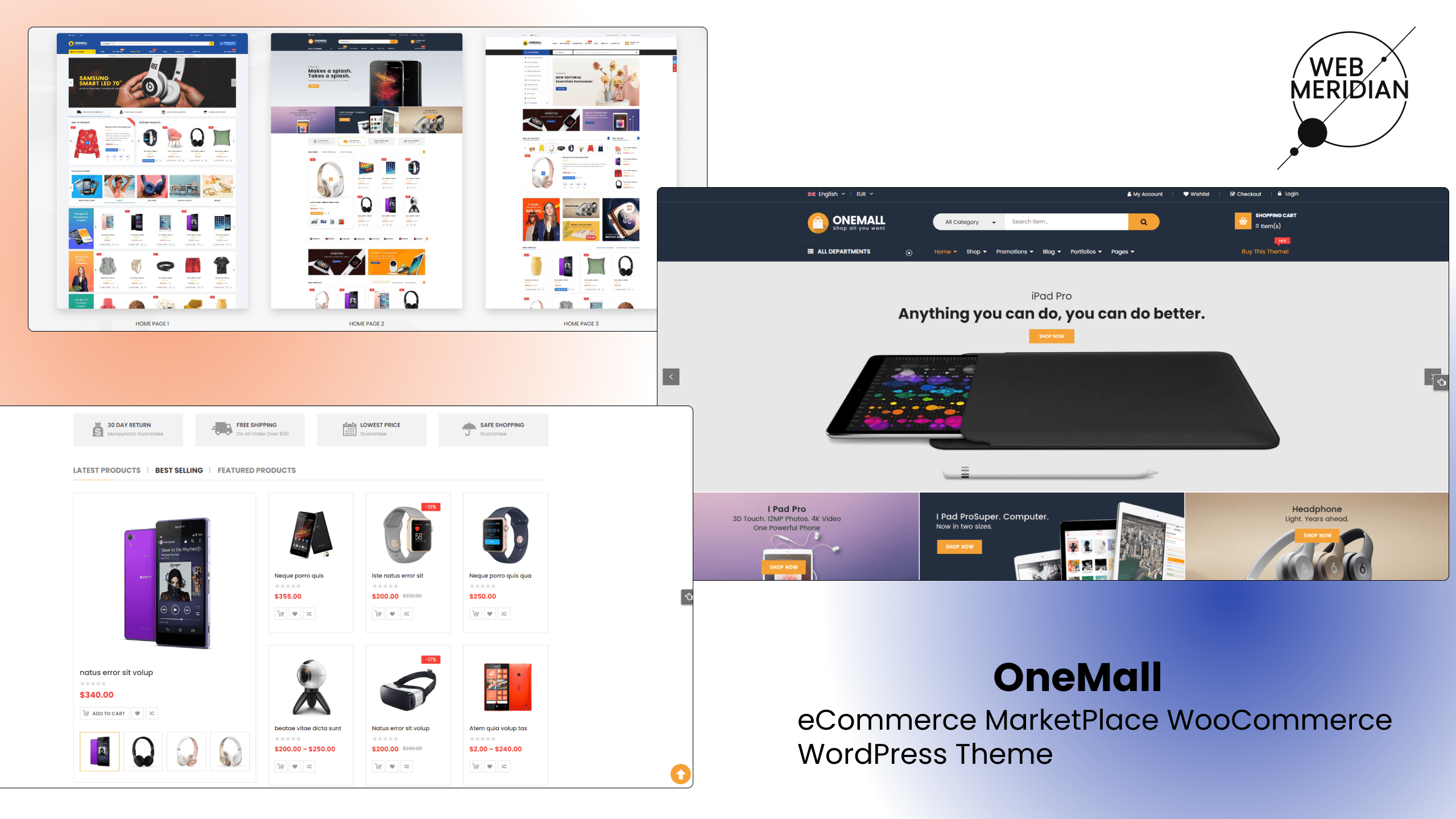
Mayosis is perfect for digital products. Showcase your ebooks, music, or software with ease.
Martfury is a stylish choice for fashion or lifestyle. It looks great and performs well.
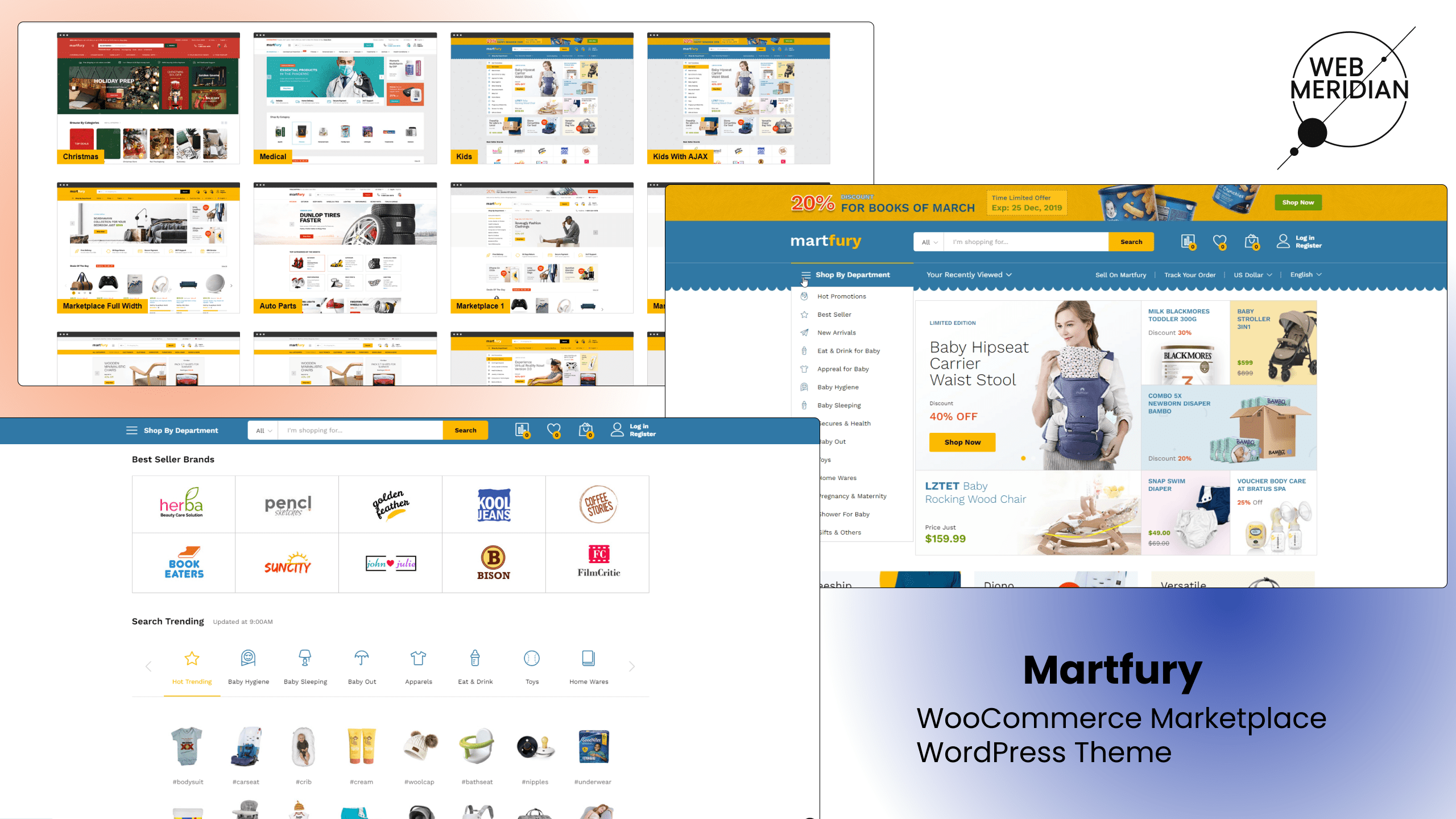
Aora is ideal for home and living. Clean, modern, and perfect for showcasing products.
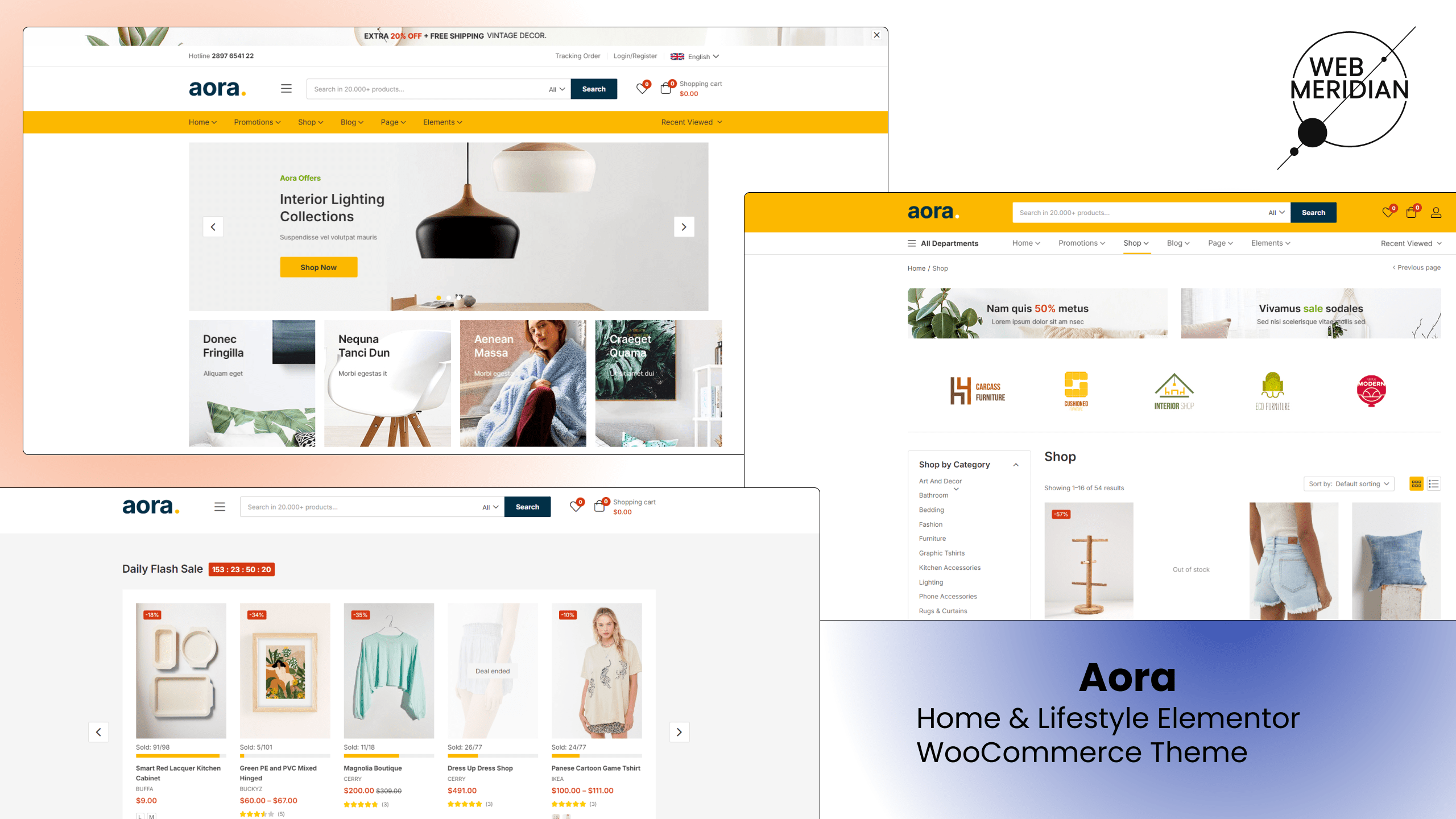
HireBee is for service-based marketplaces. It’s simple, clean, and focused on freelancers.
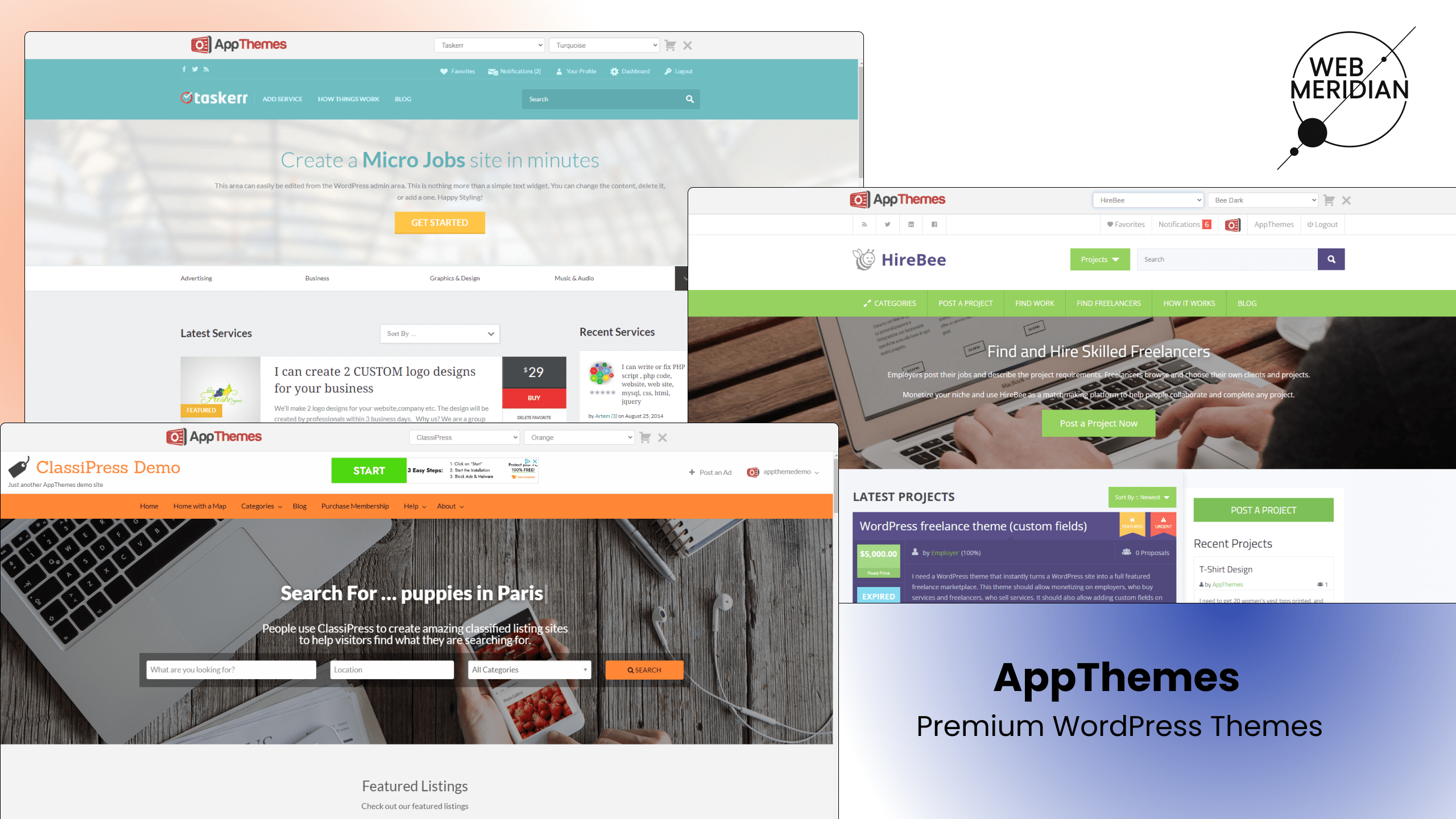
Marketo is a flexible option for various marketplaces. Tons of pre-built demos and easy customization.
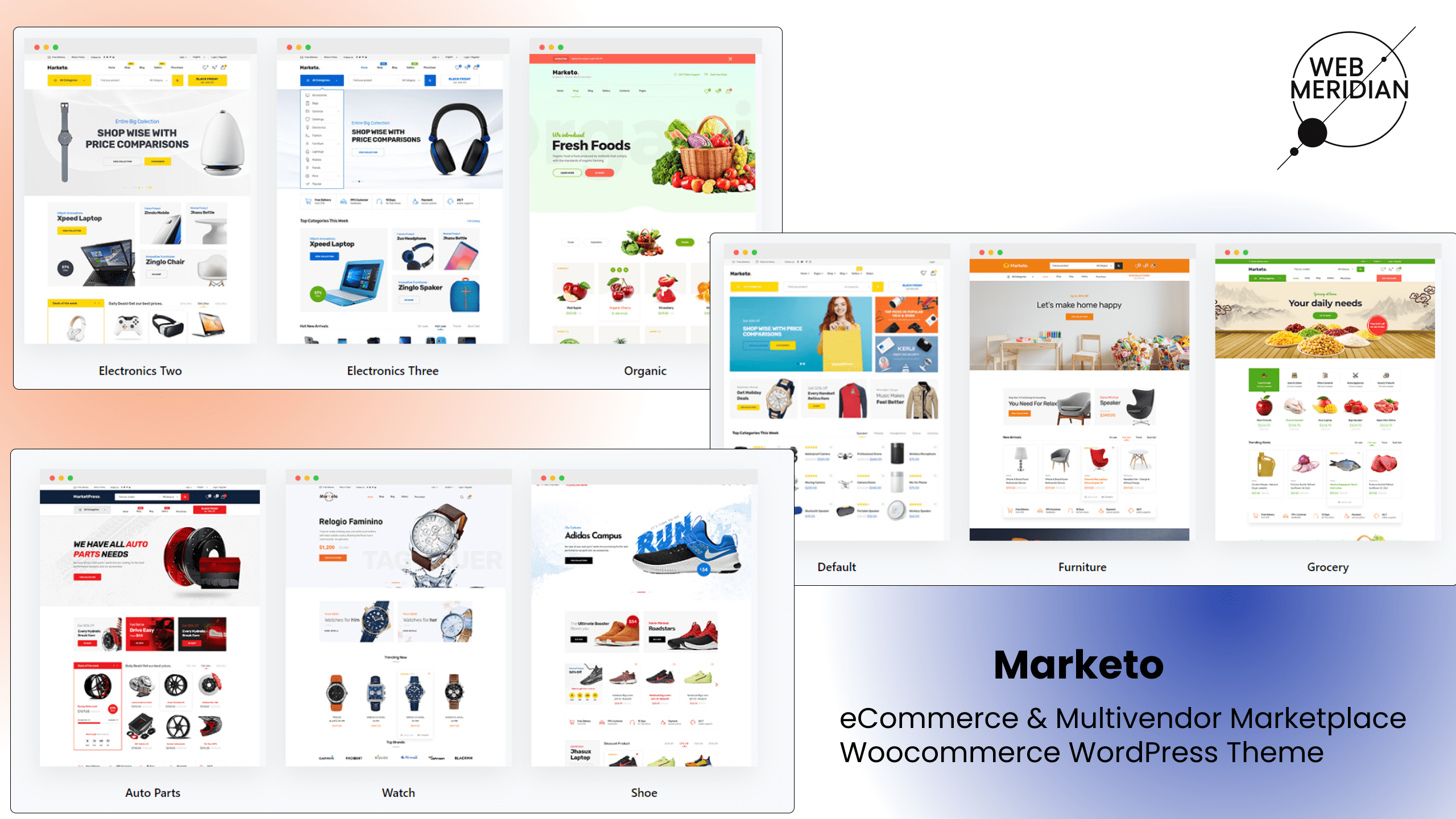
Handy is perfect for handmade goods. It has a warm, inviting feel.
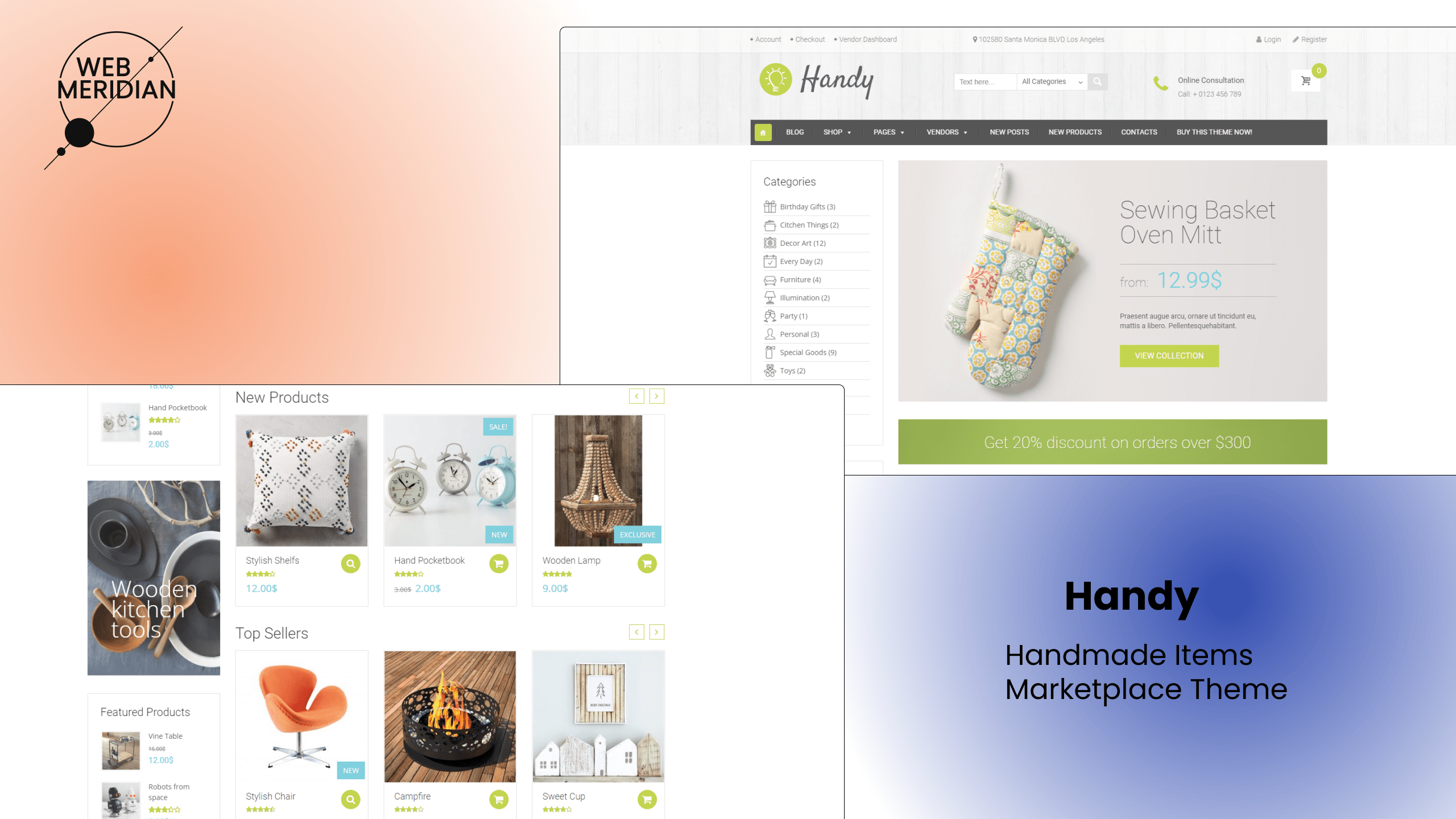
Remember, the best theme for you depends on your specific needs. So take your time, explore your options, and choose the one that’s the perfect fit for your multi-vendor eCommerce empire.
Best WordPress Plugins for eCommerce Marketplace Development
Optimize your eCommerce marketplace development with WordPress plugins tailored for creating a multi-vendor marketplace open-source.
| Plugin | Best for... | Pricing model | Impact on Multi-vendor marketplace | Notes |
|---|---|---|---|---|
| WooCommerce | Core eCommerce platform | Freemium | Solid foundation for a marketplace | Requires additional plugins for multi-vendor functionality |
| Dokan Multivendor Marketplace | Comprehensive marketplace solution | Freemium | Offers a wide range of features | Can be complex to set up |
| WC Vendors | Multi-vendor functionality for WooCommerce | Freemium | Integrates seamlessly with WooCommerce | Offers essential features for vendor management |
| YITH WooCommerce Vendors | Multi-vendor functionality | Paid | Provides advanced features | Consider cost and feature set |
| WCFM Marketplace | All-in-one marketplace solution | Freemium | Offers a wide range of features | Can be complex to set up |
| FacetWP | Product filtering and search | Paid | Improves product discoverability | Essential for large marketplaces |
| WooCommerce Product Table by barn2 | Product table display | Paid | Can enhance user experience | Popular for alternative product views |
| AffiliateWP | Affiliate marketing integration | Paid | Can increase sales and customer acquisition | |
| WP User Frontend | User-friendly frontend submissions | Freemium | Allows vendors to manage their store directly | |
Successful examples of an eCommerce marketplace built on WordPress
Ever wonder how giants like ThemeForest, Envato Elements, and CodeCanyon manage massive marketplaces? While custom tech is likely involved, WordPress might be a secret ingredient.
These platforms resemble multi-vendor marketplaces – think creators selling digital assets like themes or plugins. This mirrors open-source solutions like WooCommerce, popular for multi-vendor eCommerce development. Imagine WordPress powering seller tools: registration, product uploads, and communication. It frees Envato to focus on buyer experience and platform growth.
So, next time you download a theme, there might be WordPress magic behind the scenes without any extra multi-vendor eCommerce website developers.
Multi-vendor Marketplace Developers: What Is Their Rate And Where To Find Them?
| Technology | Rate, EUR per hour | Technology | Rate, EUR per hour |
|---|---|---|---|
| Magento Developer | 40-60 | Hyva Developer | 40-60 |
| Shopify Developer | 35-50 | React Developer | 35-50 |
| Shopware Developer | 45-60 | WooCommerce (WordPress) Developer | 35-50 |
The rate and monthly fee depend on various factors and aren’t universally fixed for all types of projects. The developer’s hourly rate is influenced by several key factors:
- Project complexity, including the number of integrations, modules, and complex features, outdated version of the eCommerce platform, incompatibilities, AI features, configurators, etc.
- The seniority of the developer (junior, middle, or senior) and Adobe certification.
- The specific requirements of the project.
NOTE: It’s essential to understand that calculating the project monthly fee isn’t as straightforward as multiplying the developer’s rate by the hours worked.
Simply put, tackling the issues on your eCommerce site, whether it’s eCommerce marketplace development from scratch up or expanding the feature set, requires a team effort. It’s not a one-person show – we bring together different experts like the Quality Assurance team, Project Manager, Business Analyst, DevOps, and other eCommerce tech experts to make sure everything runs smoothly.
The total project cost is adaptable, and as such, it requires a thorough discussion of your needs during the requirements definition stage to provide an accurate estimation.
Multi-Vendor Marketplace Developers: Where To Find Them?
Hiring a multi vendor marketplace developer can be a complex task. There are several avenues to explore, each with its own set of advantages and disadvantages.
Searching for Freelancers
One common approach is to look for individual freelancers on platforms like Upwork or Freelancer. These platforms host a vast pool of talent from around the world, offering flexibility and a wide range of skill sets.
Advantages:
- Cost-Effectiveness: Often, hiring freelancers can be more cost-effective than engaging a full development agency.
- Flexibility: Freelancers can usually adapt to your schedule and can be hired on a per-project basis.
Disadvantages:
- Inconsistency in Quality: The skill levels and professionalism of freelancers can vary widely.
- Project Management Challenges: Managing a team of freelancers, especially if they are from different time zones, can be challenging.
Hiring Developers on Outstaffing Terms
Another option is outstaffing, where you hire developers from another company to work exclusively on your project. This can be done by reaching out to companies specializing in multi-vendor marketplace development and who offer outstaffing services.
Advantages:
- Expertise and Experience: Companies specializing in marketplace development likely have a track record and specific expertise in this domain.
- Reliability: Outstaffing offers more stability and reliability compared to freelancers, as developers are part of an established organization.
Disadvantages:
- Higher Costs: Hiring through outstaffing can be more expensive than freelancers.
WebMeridian’s Outstaffing Model
At WebMeridian, we support the outstaffing model and can provide developers and other specialists with experience in Multi-vendor Marketplace Development for projects. Our team of professionals brings a wealth of knowledge and experience in this area, ensuring that your project will be handled with the utmost care and expertise.
Why Choose WebMeridian?
- Experienced Professionals: Our team comprises experienced individuals in multi-vendor marketplace development.
- Seamless Integration: We ensure our team integrates smoothly with your project, aligning with your goals and objectives.
- Comprehensive Support: From development to post-launch support, WebMeridian offers a full range of services to ensure the success of your project.
In summary, whether you choose individual freelancers or outstaffing through a company like WebMeridian, it’s important to weigh the pros and cons of each option in the context of your project’s specific needs and goals. With WebMeridian, you can rest assured that your multi-vendor marketplace development is in capable hands.
Start Building a User-Friendly Multi-Vendor Marketplace
Creating a successful online marketplace involves making many crucial decisions, such as identifying the right business niche, choosing the most suitable platform, attracting sellers and buyers, and more. Each step is vital in shaping your marketplace’s success and future growth.
Our team has years of experience in creating eCommerce multi-vendor marketplaces. We can help you to find one that fits your vision and is equipped to evolve with your business needs.
Contact us to discuss the next steps to building a multi-vendor marketplace for your niche.



